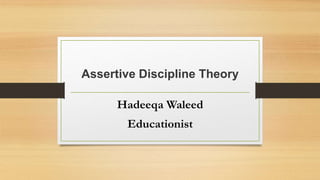
Assertive discipline theory
- 1. Assertive Discipline Theory Hadeeqa Waleed Educationist
- 2. • Assertive discipline is a structured system to enable teachers to manage their classrooms. It focuses on the teacher developing a positive behaviour management strategy rather than being dictatorial. • Canter’s proposition is that the teacher has the right to decide what is best for their students and that no student should prevent any other from learning.
- 3. • The teacher should very clear boundaries as to how they expect their students to behave and work, the students should know what these boundaries are and any deviation should be met with an assertive action from the teacher. • However, if the teacher gives a firm, clear instruction and those instructions are met, they should be followed by positive reinforcement (see Skinner above). Any deviation from the instruction should be met with negative consequences that the students have prior knowledge of.
- 5. Eleven Key Features of Assertive Discipline Theory 1. The Right To Learn. Canter introduced the concept of students’ rights to classroom discipline theory. According to Canter, well-behaved students have the right to learn in a classroom without distraction. This means that the teacher must discipline poorly behaved students in the best interests of the rest of the class. Canter also notes that students have the right to learn from a caring teacher who has their students’ best interests at heart. 1. The Right to Teach. Teachers should be given the same right to a peaceful working environment as other professionals. Students who misbehave or are rude undermine a teacher’s rights at work. Teachers also deserve the support of their administration and managers as well as their students’ parents.
- 6. 1.Teachers must be in Control. Canter is critical of behavior management approaches that dilute the control of the teacher. The teacher, as the adult in the room, has the responsibility and duty to control the classroom environment. This is the only way the students’ safety and educational development can be guaranteed. 1.Clear Boundaries must be Set. A teacher needs to develop a clear discipline plan. This plan should unambiguously state the boundaries of appropriate vs. inappropriate behaviors in the classroom. It should also state for students the exact corrective actions that will occur if students do not respect those boundaries. Students and parents need to understand and consent to the rules.
- 7. 1.Positive Reinforcement. Teachers should ‘catch’ students who are behaving well within the classroom and provide rewards and praise for that positive behavior. Teachers should publicly acknowledge positive behaviors of one student in front of the whole class. Recognition and acknowledgement of everyday positive behaviors will show students who respect class rules that their compliance and respectful manners are appreciated. 1.Positive Repetition. Like positive reinforcement, positive repetition involves publicly acknowledging positive behaviors. Furthermore, it involves repeating instructions and explicitly stating the positive behavior in the statement of recognition. Examples of restating rules in acknowledgement include: “James waited at the door before getting permission to enter. Great job, James!” The rule in this case would have been to “Wait at the door to get permission before entering.”
- 8. 1.Firm Consequences. While the Canters highlight that proactive and positive discipline are ideal, when students overstep boundaries, consequences must follow. These consequences must be written down in advance (on the discipline plan), followed-through in all instances, and applied equally to all students. By following-through with your consequences plan, students learn that the rules are serious and must be respected. 1.Behaviors should be taught through Modelled and Direct Instruction. It is not enough to simply enforce rules with rewards and punishments. To earn the respect and trust of students, teachers should always behave within the guidelines of the rules they have set out for students. This includes modelling positive and respectful behavior at all times so students see how it’s done. Furthermore, teachers need to directly instruct students on how to behave by explicitly repeating the roles and insting upon them being followed.
- 9. 1.It is possible to Teach Difficult Students. Canter’s original research in classroom management took place with students with special needs. Based on his work, Canter argued that most students will react well to an assertive discipline approach, including more ‘difficult’ students. 1.Proactive Discipline is better than Reactive Discipline. Proactive discipline involves anticipating poor behavior and making a plan on how to prevent it. Reactive discipline involves waiting until a student has misbehaved before coming up with a disciplinary response. Assertive discipline prioritizes proactive strategies such as setting up classroom rules and praising positive behavior.
- 10. • Teachers should build Relationships with their Students. • Canter and Canter (1996) place strong emphasis on trust. They believe that discipline in the classroom is easiest to achieve when students trust and respect their teacher. When students have this trust, they will follow the teacher’s lead and acknowledge their moral authority to set rules. Canter and Canter state that trust can be built through getting to know students, greeting them by name, learning about their interests, having personal one-to-one conversations with them, acknowledging birthdays and special events, and getting to know their parents well.